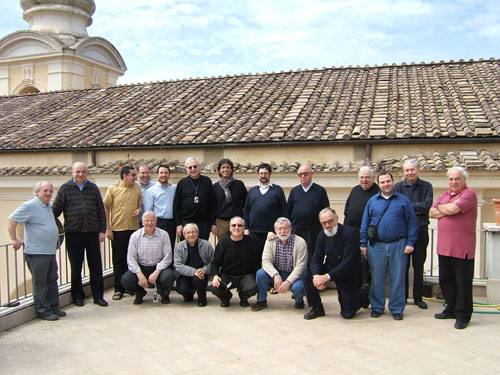Claretian Missionaries in Rome and The Vatican
 Claretians in Rome have numerous meaningful ministries today—all rooted in a history that reaches back more than 150 years. After the Claretians were founded in 1849 by St. Anthony Mary Claret, Fr. Claret traveled to Rome twice: to consult with the Pope, and to celebrate the first Vatican Council.
Claretians in Rome have numerous meaningful ministries today—all rooted in a history that reaches back more than 150 years. After the Claretians were founded in 1849 by St. Anthony Mary Claret, Fr. Claret traveled to Rome twice: to consult with the Pope, and to celebrate the first Vatican Council.
It wasn’t until 14 years later that the Claretian Missionaries finally established themselves with a headquarters in Rome. On December 30, 1884, the first Claretians were sent to represent the Claretians before the Holy See. This was the first job of the Claretian Missionaries in Vatican City.
In these early days, the Claretian Missionaries moved around the city from one provisional residence to another. Soon, young Claretians were sent to do their studies in Rome. At the same time, the Claretians began to work on pastoral activities in parishes throughout the city. In 1912, the Claretians were entrusted with the administering the parish of Santa Lucia del Gonfalone, built in 1764, and in turn they settled in their first stable residence at Via dei Banchi Vecchi, in the historical center of Rome.
The oldest community of Claretian Missionaries in Rome can still be found at Via dei Banchi Vecchi, where they continue to staff Santa Lucia. Here is also the headquarters of the Government of the Delegation and a home for retired Claretians.
In the early 1900’s, young personalities started to emerge within the Claretian Congregation who taught at many of the Roman Universities. Some of them would even participate in the Second Vatican Council many years later.
In 1920, the Claretian Missionaries founded a magazine that still holds great prestige in the Faculties of Law in Rome, entitiled Commentarium pro Religiosis. They also published the Institutum Luridicum. Still today, the Claretians in Rome are a resource to a number of Law professors of the Roman Universities and are consultants of some of the departments of the Holy See. Claretian publications about Canonic Law and Religious Life are highly valued there.
In 1922, the Claretians accepted a free piece of land given to them by the Holy See in the residential area of Parioli, Rome, for the construction of a temple dedicated to the Heart of Mary. The project was given to the famous architect Armando Brasini for construction. On May 9, 1936 the new parish-Basilica was completed and the Claretians dedicated it to the Heart of Mary.
There are many activities that take place in this Claretian Basilica today, including the sacraments, catechesis, programs for families and youth, theatrical activities, social meetings, and ministries which call attention to the plight of immigrants. The Basilica also houses the remains of two deceased Claretian cardinals, Fr. Arcadio M. Larraona, C.M.F. and Fr. Arturo Tabera, C.M.F.
In 1953 the Claretians’ highest governing body in Rome, the General Curia, moved near the Basilica of the Heart of Mary. Currently, from this location, the whole coordination for the Congregation throughout the world takes place. It is the place of residency for the Claretian General Government, as well as the home of the young Claretian priests that come to Rome to specialize in the different academic disciplines. Here is also the General Archive of the Congregation, where documents as important as the Autobiography of Saint Anthony Claret and the records of the first meetings of the Claretians are kept. There is a small museum here that houses relics of St. Anthony Claret. The Basilica is the center of publications and information for the entire Claretian congregation, which spans more than 60 countries and a community of more than 3000 priests and brothers.
It has been nearly 150 years since the Claretian Missionaries set foot in Rome. Their history has fulfilled the dreams of St. Anthony Mary Claret, and their presence continues to be of great importance--not only to the Claretians throughout the world who look to their headquarters in Rome for guidance, but also to the many people they serve.
